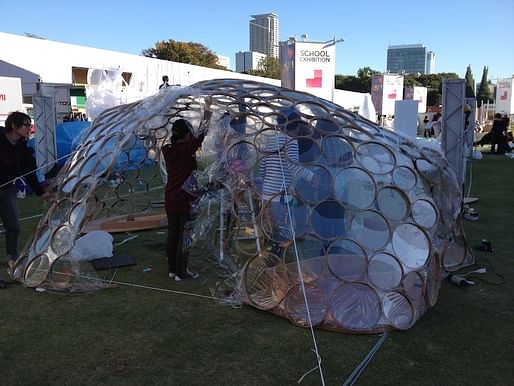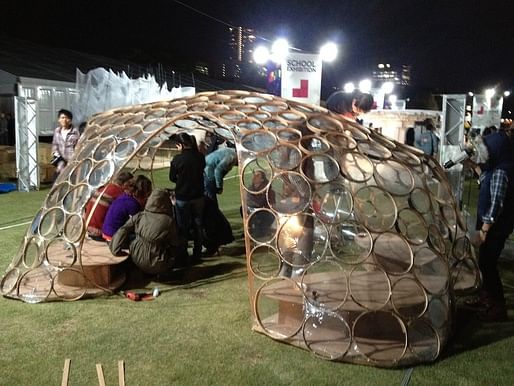
Oct '12 - May '13

Six weeks into the G30 program, I can report that I’m starting to settle back into the studio groove (ie the last train home at 12:17). My classmates, eight of us hailing from China, Mexico, Portugal, Macedonia, S Korea, Spain and myself from the US, are all in the process of adapting to the Japanese lab environment. What’s perhaps unique for all of us is that, unlike a studio semester based curriculum of traditional architectural masters programs, our studies are conducted almost exclusively within our lab setting. Aside from two guest lecture courses, Architecture and Cities in Japan; and Urban Regeneration - both of which are veritable grab bags regarding the topic du jour and their pertinence to the course titles - our focus is predominately on expanding the field of research of cybernetic urbanism championed by the lab’s professor Yusuke Obuchi (I’ll define cybernetic urbanism later when I understand it myself, but for now perhaps you can look into some of the past work of the AA’s Design Research Lab where Obuchi-sensei was previously a director). Included within our lab activities, however, are a variety of learning opportunities, including weekly Maya, Processing, and Rhino tutorials, and design workshops (I'll get into the details of the workshops in a later post).
Perhaps the most engaging component to are studies thus far have been the construction of a minimal material pavilion for the Tokyo Designers Week. While design lead is conducted primarily by a PhD student and a few second year masters students, the whole lab participated in it’s construction. The general idea behind the pavilion is to seek innovative form through the minimal use of materials. Dubbed the Circle-Pack Pavilion, the structure consists of hundreds of bamboo rings fabricated to a series of different sizes ranging from 250-450 mm in diameter. These rings were then modeled in Rhino and positioned in such a way that when brought together, the resultant dome formation would occur. Connecting the rings is a clear plastic shrink film which provides rigidity and tension to the components when heated. After working for a few weeks on the fabrication of the rings from bamboo strips, which needed to be wet, bent and headed to curvature, the final assembly and erection took the lab close to three days to complete. The result, however, was quite impressive and garnered much attention during the Tokyo Designers Week event.
 Packing the rings - paper templates were used to arrange the cells, then the plastic shrink film was adhered by sandwiching the film between two stacked rings, one of slightly smaller diameter.
Packing the rings - paper templates were used to arrange the cells, then the plastic shrink film was adhered by sandwiching the film between two stacked rings, one of slightly smaller diameter.
 Initial testing...
Initial testing...
 Working out the base connections.
Working out the base connections.
 Erecting the pavilion on site in Tokyo.
Erecting the pavilion on site in Tokyo.
 The finished project, complete with edge details and benches.
The finished project, complete with edge details and benches.
 Our neighbor, the guy is sitting on a step ladder but because all the fabric was blowing in the wind it looked like he was floating in a cloud. Many Japanese universities participated in the event and it was neat to see the design direction many of them had taken.
Our neighbor, the guy is sitting on a step ladder but because all the fabric was blowing in the wind it looked like he was floating in a cloud. Many Japanese universities participated in the event and it was neat to see the design direction many of them had taken.
 Celebrating with some sushi and other dishes at an izakaya restaurant near the site.
Celebrating with some sushi and other dishes at an izakaya restaurant near the site.
 Because the pavilion will be on display again next week at an architectural event in Shinjuku, we are trying to collapse the pavilion without fully dismantling it as a way to save everyone's time.
Because the pavilion will be on display again next week at an architectural event in Shinjuku, we are trying to collapse the pavilion without fully dismantling it as a way to save everyone's time.
The G30 is an English language, architecture and urbanism course offered through the University of Tokyo for foreign students. Led by former AA Design Research Lab Co-Director, Associate Professor Yusuke Obuchi, the program seeks to collaboratively advance architectural and urban design research through the symbiosis of digital technologies and material development.


No Comments
Block this user
Are you sure you want to block this user and hide all related comments throughout the site?
Archinect
This is your first comment on Archinect. Your comment will be visible once approved.